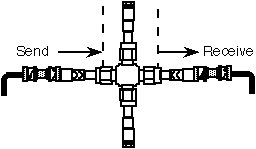 Acoustic Measurements
in Supercritical Fluids
Acoustic Measurements
in Supercritical Fluids
Introduction
Supercritical fluids have great potential as media for chemical reactions
but phase behaviour can have a substantial influence on the chemistry.
Acoustic measurements offer an effective method for monitoring this phase
behaviour.
Reactions in supercritical fluids are a major research topic in the
Department of Chemistry while acoustic measurements are a longstanding
interest in the Department of Physics (Dr
P. J. King and Dr
C. J. Mellor). Therefore, we are combining our expertise to improve
and extend acoustic measurements in supercritical reaction mixtures.
The Problem
Supercritical fluids, particularly CO2, are becoming increasingly
attractive as environmentally acceptable replacements for organic solvents.
However, a greater attraction is the possibility that chemical processes
may be different under supercritical conditions from those in conventional
solvents. It is therefore becoming important to measure the critical
point of each reaction mixture. The problem is that even the simplest
reaction mixture will contain at least three components (reactant, product
and solvent), and during the reaction, its composition will change as a
function of time. Thus, reaction mixtures are inherently more complicated
than most of the supercritical systems that have been studied in the past.
The Solution
Traditionally phase behaviour has been measured either visually or by sampling.
The visual method is difficult to apply to mixtures where the refractive
indices of the phases are similar and the phase boundary is indistinct
even in sub-critical conditions. The sampling method is a relatively tedious
process which is generally used in conjunction with visual methods to establish
the precise composition of the separate phases. Recently, we have shown
that acoustic measurements can be used to locate the critical point of
mixtures relevant to reaction chemistry in supercritical fluids.

-
The principle of the measurement is that the speed of sound reaches a minimum
at the critical point.
-
Our approach therefore involves measuring the speed of sound as a function
of temperature and pressure.
-
The method is more objective than visual methods and produces critical
parameters acceptably close to literature values where these have been
available. Most importantly, it has already produced data for ternary mixtures
of chemical importance, eg. CO+ C2H4 + CH3CH=CH2,
which have defeated traditional methods of phase measurement.
|

High Pressure hand pump used in acoustic measurements. |
Further Information
For further information please contact M.
Poliakoff
Key Publications from Nottingham
-
Probing Vapor/Liquid-Equilibria of Near-Critical Mixtures by Acoustic Measurements,
A. Kordikowski, D. G. Robertson, A. I. Ricardo, V. K. Popov, S. M. Howdle
and M. Poliakoff, J. Phys. Chem, 1996, 100, 9522-6
-
Acoustic Determination of the Helium Content of Carbon Dioxide from He-Head-Pressure
Cylinders and FTIR Studies of the Density of the Resulting Supercritical
CO2: Implications for Reproducibility in Supercritical Experiments,
A. Kordikowski, D. G. Robertson and M. Poliakoff, Analytical Chem,
1996, 68, 4436-40.
-
Acoustic Probing of Phase Equilibria in Near Critical Fluids,
Kordikowski A. and Poliakoff M. Fluid Phase Equilibria, 1998 150/1,
5493-99.
-
The Vapor-Liquid Equilibrium and Critical Line of the CO2 + Xe System,
Ribeiro N., Casimiro T., Duarte C., Nunes da Ponte M., Aguir-Ricardo A.
and Poliakoff M. J. Phys. Chem. B. 2000, 104, 791-5.
University of Nottingham Welcome
page
Inorganic
Chemistry Welcome page
The Clean Technology
Research Group Welcome page
Page created by: Simon Poliakoff
Created: July 1997
Last Revised: January 2001

